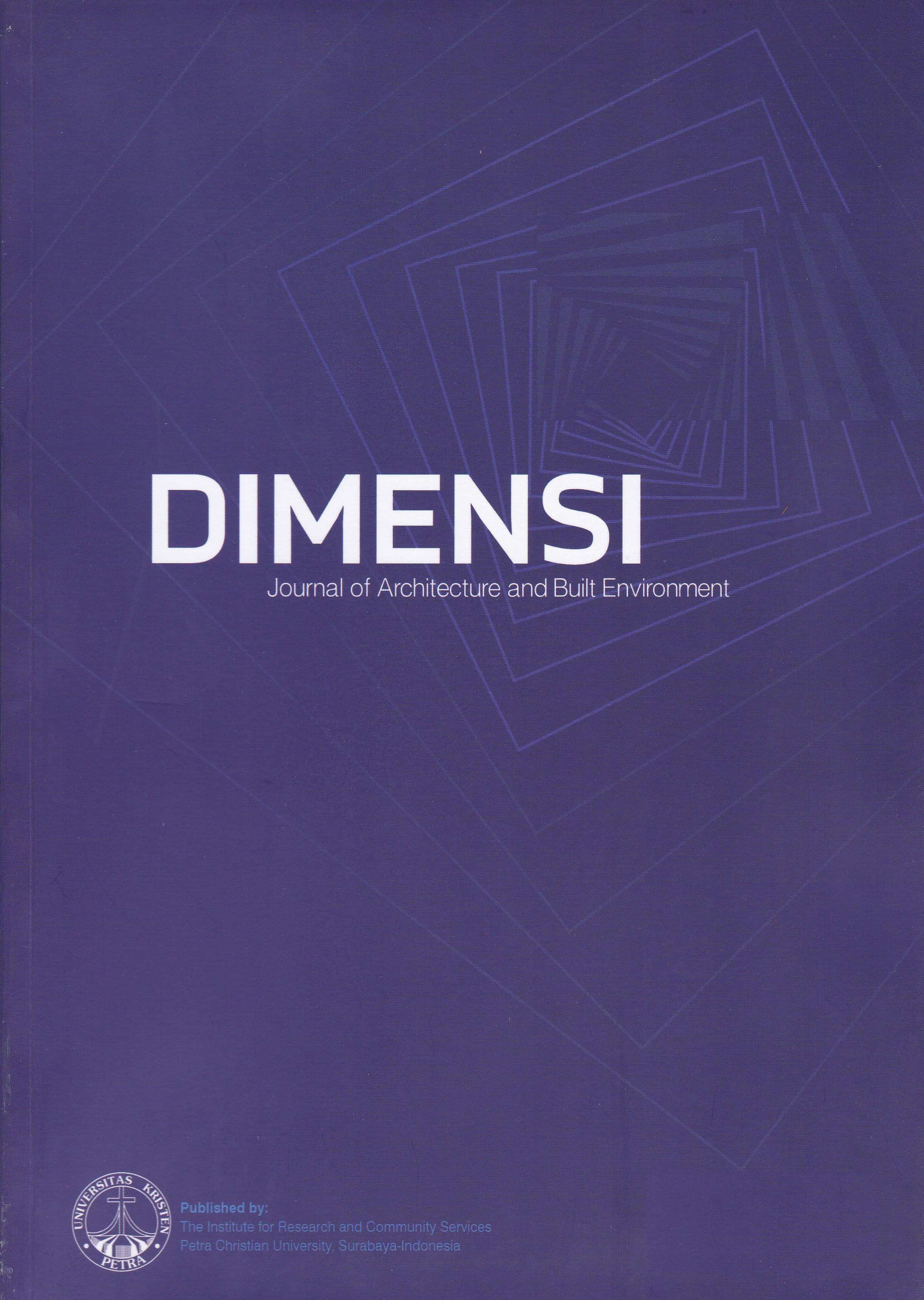CONSOLIDATION OF URBAN VILLAGE SETTLEMENT PATTERNS USING HYBRID ARCHITECTURE CONCEPT APPROACH; Case Study: Densely Populated Settlement of Sindulang Satu Village, Manado
DOI:
https://doi.org/10.9744/dimensi.46.2.103-116Keywords:
consolidation, settlement pattern, hybrid concept.Abstract
The hybrid concept that develops in urban community settlements in an unplaning manner has led to various forms of settlement patterns that are adapted to social, economic and environmental conditions. This hybridity condition is potential for more innovative settlement consolidation efforts. This research was conducted to examine the quality of the hybridity formed in urban village settlements in Sindulang Satu Village, Manado, and to find the consolidation principle of settlement patterns by developing hybridity values at the site location. The quality of the hybridity was examined based on the perspective of programming hybrid, operational hybrid and spatial hybrid. This study used a qualitative research method, with modeling and experimental simulation technique approach. The analysis of settlement space performance was done by statistical calculations and graphical analysis using space syntax method. The research data was obtained using questionnaire, interviews and observations methods of samples that met the criteria of purposive sampling. The results of this study showed the potential of the hybridity in site locations with good quality, so that it became a consideration in formulating the principle of settlement pattern consolidation to increase site hybridity.Downloads
References
Alexander, E. R. (1993). “Density Measures: A Review and Analysis”. Journal of Architectural and Planning Research, Vol.10 (3), p.181-202.
Amin, A. (2006). “Collective Culture and Urban Public Space”, In City Vol.12 (1). p.5-24.
Cheng, V. (2010). “Understanding Density and High Density”, in L. Ng (ed), “Desinging High-Density Cities For Social and Environmental Sustainability”. p.3-16. London: Earthscan.
Cho, I. S., Heng, C. K., & Trinic, Z. (2016). “Re-Fraing Urban Space: Urban Design For Hybrid and High-density Conditions”. New York: Routledge.
Dinas Komunikasi dan Informatika Pemerintah Kota Manado. (2017, May 19). Pemerintah Kota Manado. Retrieved from https://manadokota.go.id/index.php /2017/05/19/mengenal-kecamatan-sario/
Fenton, J. (1985). “Hybrid Building”. San Francisco: Library of Congress Catalogue Card No. 82-062717.
Hillier, B. (2007). “Space is The Machine: A Configurational Theory of Architecture”. London: Space Syntax, Electronic Edition.
Hillier, B dan Hanson, J. (1984). “The Social Logic of Space”. Cambridge; New York: Cambridge University Press.
Kurokawa, K. (1991). “Intercultural Architecture, A Philosofy of Symbiosis”. London: Academy Group Ltd. & Khiso Kurokawa.
Malnar, J. M., & Vodvarka, F. (2004). “Sensory Design”. Minneapolis: University of Minnesota Press.
Mozas, J. (2014). “This Is Hybrid, In This Is Hybrid: An analysis of mixed-use buildings”. (p. 38-41). Spainyol: a+t architecture publishers .
Muhi, A. (2012). “Fenomena Pembangunan Desa”. Online: http://alimuhi.staff.ipdn.ac.id/wp-content/uploads/2012/06/FENOMENA-PEMBANGUNAN-DESA.pdf. ( diakses 27 Juni 2018)
Nugroho, A. C. (2010). “Spatial Enclosure Sebagai Dasar Penataan Kampung Kota”. Jurnal Arsitektur Universitas Bandar Lampung. Vol.1 (1). p.26-28.
Prayitno, B. (2012). “An Analysis on Spatial Permeability and Fluida Dynamics of Wind and Termal in Tropical Riverside settlement areas of Banjarmasin City, Indonesia”. Jurnal Manusia dan Lingkungan. Vol.20 (2)
Prayitno, B. (2013). “An analysis of Consolidation Patterns of Kampong Alley Living Space in Yogyakarta, Indonesia”. Journal of Habitat Enginering and Design. Vol.5 (1). p. 99-112.
Prayitno, B. (2017). “Integrated Sustainable Kampong Hybrid in Code Riverside Settlement in Yogyakarta, Indonesia”. 3rd International Conference on Engineering of Tarumanagara “Smart Engineering for Future Cities”. Jakarta, 04-05 October 2017. Jakarta-Indonesia. p.40-49
Prayitno, B. (____). “Hybrid Cityblock Development, Sustainable Habitat”. Engineering: The Architecture of Engineering and Policy, Pusperkim UGM. Yogyakarta.
Uytenhaak, R.,. Mensink, J,. & Melet, E. (2008). “Cities Full of Space: Qualities of Density”. Rotterdam: 010 Publisher.
Zahn, M. (1999). “Perancangan Kota Secara Terpadu: Teori Perancangan Kota dan Penerapannya”. Yogyakarta: Kanisius.
Downloads
Published
How to Cite
Issue
Section
License
Authors who publish with this journal agree to the following terms:
- Authors retain copyright and grant the journal right of first publication with the work simultaneously licensed under a Creative Commons Attribution License that allows others to share the work with an acknowledgement of the work's authorship and initial publication in this journal.
- Authors are able to enter into separate, additional contractual arrangements for the non-exclusive distribution of the journal's published version of the work (e.g., post it to an institutional repository or publish it in a book), with an acknowledgement of its initial publication in this journal.
- Authors are permitted and encouraged to post their work online (e.g., in institutional repositories or on their website) prior to and during the submission process, as it can lead to productive exchanges, as well as earlier and greater citation of published work (See The Effect of Open Access).



















